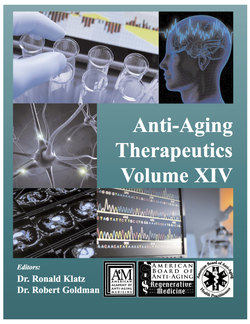Читать книгу Anti-Aging Therapeutics Volume XIV - A4M American Academy - Страница 35
На сайте Литреса книга снята с продажи.
Female Clinical Studies
ОглавлениеTestosterone has wide ranging biological effects in pre and postmenopausal women, in part because of widespread androgen receptors found in the brain, spinal cord, nerves, breast, bone, muscles, cardiovascular system, gastrointestinal tract, lungs, bladder, vaginal tissue, uterus, skin, hair follicles and adipose tissue. Testosterone also exerts its effect indirectly via aromatization to estrogen in these organs, ovary and adrenal gland. Greenblatt and Suran3 recommended the use of testosterone pellets in women for a variety of different reasons, including:
•Menopausal syndrome in whom estrogen replacement therapy (ERT) has proved unsatisfactory or is contraindicated;
•Dysmenorrheic patient with endometriosis or small fibromyomata (for whom surgery is not feasible);
•Nocturia of endocrine origin;
•Desire to increase libido;
•Palliative measure in patients with advanced carcinoma of the breast;
•In combination with desoxycorticosterone pellets for Addison’s disease.
Testosterone implants in women have been shown to improve lethargy/fatigue, depression, loss of libido, and hot flashes. They have also been found to have a favorable effect on blood pressure, blood lipid profile, and blood clot formation. Indeed, in a review of testosterone implants in postmenopausal women by Sands and Studd,4 the authors conclude: “Androgen replacement therapy is a neglected area of medical practice and further research is needed to identify all women who will benefit from it since studies in menopausal women have shown parenteral administration to be well tolerated and safe. Such therapy is underused and very much under-researched.”
Glaser et al conducted a study to investigate the beneficial effects of continuous testosterone therapy, delivered by subcutaneous implant, in the relief of somatic, psychological and urogenital symptoms in both pre- and postmenopausal women. 300 pre- and postmenopausal women with symptoms of relative androgen deficiency were asked to self-administer the 11-item Menopause Rating Scale (MRS), at baseline and 3-months after the first insertion of the testosterone implant. Baseline hormone measurements, menopausal status and body mass index (BMI), were assessed to determine correlation with symptoms and clinical outcome. Results showed that premenopausal and postmenopausal females reported similar hormone deficiency symptoms. Both groups demonstrated similar improvement in total score, as well as psychological, somatic, and urogenital subscale scores with testosterone therapy. Better effect was noted in women with more severe complaints. Higher doses of testosterone correlated with greater improvement in symptoms.
So, TPI can be of considerable benefit to premenopausal women as well as postmenopausal women. It is important to remember that women may have deficient hormone levels as early as their early-to-mid thirties (premature ovarian failure). Hormone levels fluctuate greatly in some women before menopause causing:
•Premenstrual syndrome (PMS);
•Menstrual or migraine headaches (TPI will alleviate 90%);
•Sleep disorders.
Testosterone pellets can “even out” the fluctuating hormones and dramatically improve symptoms. They can be used alone without other sex hormones if a patient is symptomatic and has low levels of testosterone but other hormone levels are normal.
Worboys et al6 investigated whether testosterone negates favorable estrogenic effects on endothelial function in 33 postmenopausal women who had been on ERT for at least 6-months. Arterial reactivity was determined at baseline, and 6-weeks after implantation of a 50 mg testosterone pellet. 15 postmenopausal women not receiving any form of hormone replacement therapy (HRT) served as controls. Results showed that the testosterone implants improved both endothelial dependent (flow-mediated) and endothelial independent (glycerol trinitrate) brachial artery vasodilation in women already using ERT. No changes were observed in the control group. The authors concluded: “This supports the concept that androgens have important physiological actions in women as well as in men and provides additional, and much needed, safety data pertaining to postmenopausal testosterone use. It is important to note that the implantation of E2 pellets is not recommended at present as estrogen requires careful titration in because of the narrow optimal benefit/adverse reaction margins in some women. Pellets do not allow for this in a timely manner. Therefore transdermal or transvaginal estrogen is preferred instead of E2 pellets. In addition, testosterone is the major substrate for E2. Aromatase, at the cellular level, provides adequate amounts of E2 to the estrogen receptor. Serum levels of E2 do not accurately reflect end organ function.
